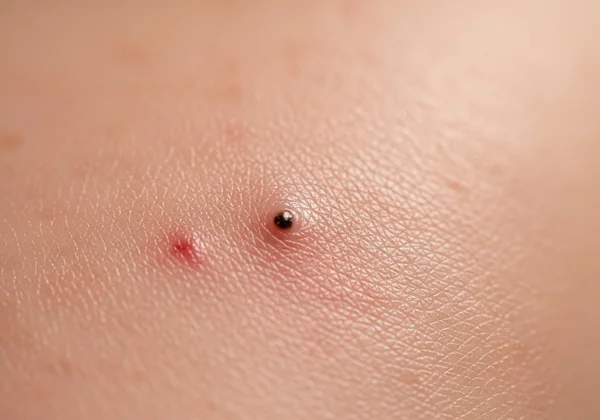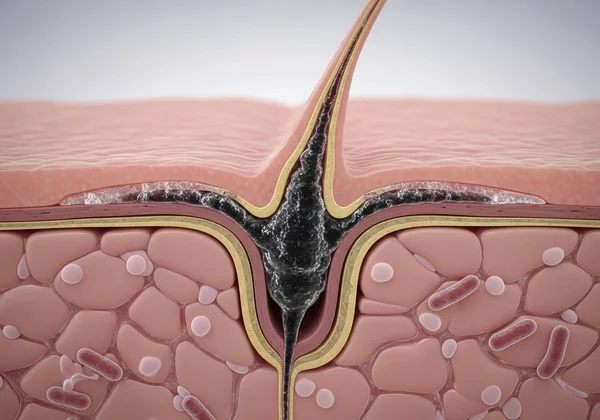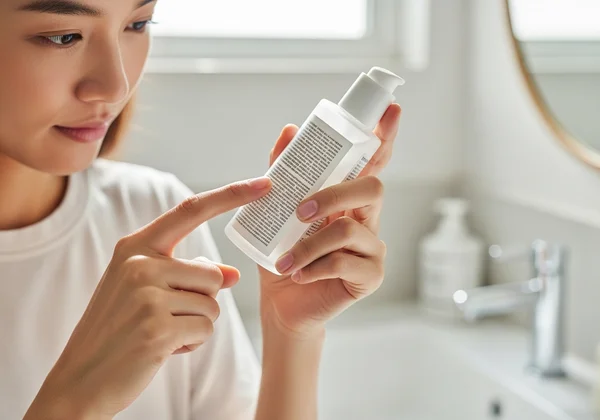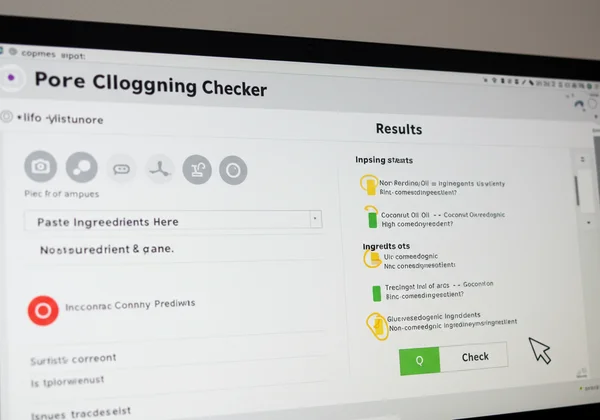Worst Pore-Clogging Ingredients: Your Comedogenic Ingredient Checker List
Are you tired of mysterious breakouts and frustrated with your skincare routine? The answer might be hidden in your beauty products. Many common skincare, makeup, and even hair products contain ingredients that silently sabotage your clear skin goals. How to use a pore clogging checker effectively and avoid these hidden culprits? This guide unveils the "Dirty Dozen" – 12 of the most common worst pore-clogging ingredients you need to watch out for, helping you to make smarter product choices for healthier, blemish-free skin. Don't let your products work against you; check your products and take control of your complexion today.

Understanding Comedogenic Ingredients & Acne-Causing Chemicals
Clear skin can feel elusive, and often, the culprits are the very products we use. It's crucial to understand the science behind breakouts and why certain acne-causing chemicals lurk in seemingly innocent formulations. Understanding skincare is empowering.
What Exactly Makes an Ingredient Pore-Clogging?
An ingredient is considered pore-clogging if it has a tendency to block the pores on your skin. This blockage can lead to the formation of blackheads, whiteheads, and ultimately, inflammatory acne. When sebum (your skin's natural oil), dead skin cells, and bacteria get trapped inside a clogged pore, it creates the perfect environment for a breakout. The comedogenicity of an ingredient is typically rated on a scale from 0 to 5, where 0 means non-comedogenic and 5 means highly comedogenic. While these ratings are often derived from older animal studies, they still offer a valuable guide for identifying potential issues. Knowing what ingredients clog pores is your first step towards preventing breakouts.

Why Identifying "Ingredients to Avoid" is Crucial for Clear Skin
For anyone struggling with acne or even occasional blemishes, identifying ingredients to avoid is paramount. Many people meticulously cleanse and treat their skin but overlook the hidden comedogenic components in their daily moisturizers, foundations, or even shampoos. These persistent pore-cloggers can undermine all your efforts, leading to a cycle of breakouts. By becoming a conscious consumer and understanding your product labels, you can proactively prevent new blemishes and help your skin heal. This preventative approach is far more effective than just treating breakouts after they appear.
The Dirty Dozen: Your Must-Avoid Comedogenic Ingredients List
This comedogenic ingredients list highlights some of the most common and potent pore-cloggers you should be wary of. While individual reactions vary, these ingredients are frequently associated with triggering breakouts.
Coconut Oil: Friend or Foe for Acne-Prone Skin?
While lauded for its natural moisturizing properties, Coconut Oil is highly comedogenic. Its heavy, occlusive nature can easily trap dead skin cells and sebum in pores, leading to breakouts, especially for those with oily or acne-prone skin. It's often found in natural skincare and hair products.
Is Lanolin Really a Culprit in Skincare?
Lanolin, a wax derived from sheep's wool, is an excellent emollient, but it can be a significant culprit in skincare for acne sufferers. Modified versions like Acetylated Lanolin or Lanolin Alcohol are often even more comedogenic than pure Lanolin. Always check for these derivatives if you have breakout concerns.
The Truth About Silicones (e.g., Dimethicone, Cyclopentasiloxane)
Silicones like Dimethicone and Cyclopentasiloxane are often debated. While they are large molecules that don't penetrate the skin, they form a breathable barrier. However, if not properly cleansed, this barrier can trap other ingredients, oil, and debris, potentially leading to clogged pores in some individuals, particularly those prone to congestion or with very oily skin. They are not inherently pore-clogging for everyone, but it's important to understand the truth about silicones for your skin type.
Heavy Butters & Waxes: Shea Butter, Cocoa Butter, and Beeswax
Natural heavy butters & waxes such as Shea Butter, Cocoa Butter, and Beeswax are deeply moisturizing but can be problematic for acne-prone skin. Their rich, occlusive textures can sit heavily on the skin, contributing to pore blockages. While beneficial for very dry, non-acneic skin, they might not be the best choice if you're trying to achieve a clearer complexion.
Specific Algae Extracts & Seaweed Derivatives to Watch Out For
Increasingly popular in "natural" formulas, certain Algae Extracts & Seaweed Derivatives can surprisingly be highly comedogenic. Ingredients like Carrageenan, Red Algae, and various forms of Seaweed are sometimes used for their skin-conditioning benefits, but they can trigger acne in sensitive individuals.
Isopropyl Myristate and Its Esters: Hidden Aggressors
Isopropyl Myristate and Its Esters (like Isopropyl Palmitate, Isopropyl Isostearate, Butyl Stearate, Myristyl Myristate) are common emollients found in lotions and creams. These are notorious hidden aggressors for causing breakouts, even in small concentrations, due to their high comedogenic ratings. Always scrutinize ingredient lists for these compounds.
Synthetic Fragrances and Certain Dyes
While not directly pore-clogging, Synthetic Fragrances and Certain Dyes (especially red dyes) can be highly irritating. Irritation can lead to inflammation, which in turn exacerbates acne. For sensitive or acne-prone skin, opting for fragrance-free and dye-free products is often a safer bet to avoid triggering breakouts.
Oleic Acid and Other Problematic Fatty Acids
Fatty acids like Oleic Acid (found in olive oil, avocado oil) can be comedogenic for some skin types. While essential for healthy skin barriers, an excess or a predisposition to react to certain fatty acids can contribute to clogged pores. Other problematic fatty acids might include Stearic Acid and Lauric Acid.
Talc: Is It a Clogging Concern?
Talc is a mineral often used as a filler or absorbent in powders and makeup. While generally considered non-comedogenic for many, for some individuals, especially when combined with skin oils and sweat, it can become problematic. Overuse or improper cleansing can make Talc a clogging concern for sensitive pores.
Carrageenan and Other Thickeners
Beyond algae extracts, Carrageenan and Other Thickeners and gelling agents used in cosmetics can sometimes contribute to a product's comedogenicity. While they help with product texture, certain compounds can sit on the skin and trap debris, leading to issues for congestion-prone skin.
Certain Red Dyes (e.g., D&C Red #17, #21)
Cosmetic Certain Red Dyes like D&C Red #17, D&C Red #21, D&C Red #3 and #40 are known for their comedogenic potential. These dyes are frequently found in blush, lipsticks, and foundations, and can be a silent source of breakouts around the mouth and cheeks.
The Overlooked Risks of Mineral Oil and Petrolatum (for some)
Mineral Oil and Petrolatum are highly occlusive ingredients, meaning they form a protective barrier on the skin. While often considered non-comedogenic in their purified forms, some argue that if they aren't fully purified or if used on already congested skin, they can trap existing impurities and worsen breakouts. Understanding the overlooked risks of Mineral Oil and Petrolatum for your specific skin is key.
Beyond the List: How to Confidently Avoid Pore-Clogging Ingredients
Knowing which ingredients might be problematic is just the beginning. The next step is allowing you to make confident choices every time you shop for beauty products. This involves more than just memorizing a comedogenic ingredient checker; it's about mastering how to vet your products effectively.
Mastering the Art of Reading Skincare Ingredient Labels
The sheer length and complexity of skincare ingredient labels can be daunting. Manufacturers list ingredients by concentration, from highest to lowest. Learn to quickly scan for the "Dirty Dozen" and other known irritants. Look for products labeled "non-comedogenic," "oil-free," or "non-acnegenic," but remember these terms aren't always regulated, which leads us to our next point. Mastering this art helps you choose acne safe product checker options.

Why "Non-Comedogenic" Labels Aren't Always Foolproof
While a "non-comedogenic" label is a good starting point, "non-comedogenic" labels aren't always foolproof. This term isn't universally regulated, and a product might be tested on a small group or under specific conditions that don't reflect real-world use or individual skin sensitivities. Always pair the label with your own ingredient scrutiny. This is where a reliable pore clog checker tool becomes invaluable.
Empower Your Skincare Decisions with PoreCloggingChecker.org
Navigating skincare ingredients can be overwhelming. That's why we created our tool – your ultimate, unbiased ally in the quest for clearer skin. Our tool acts as your personal pore clogging ingredient checker, providing instant analysis so you can make truly informed decisions.
Your Free, Unbiased Ingredient Analysis Tool
Our free, unbiased ingredient analysis tool is designed to simplify your skincare journey. We compile data from scientific research to identify known comedogenic substances. Our commitment is to provide objective information, free from brand influence or paid promotions. This means you get transparent, science-backed insights into your products. To access this powerful acne ingredient checker, simply try our free tool today.
How Our Tool Simplifies Your Product Choices in Seconds
Our platform provides a user-friendly interface that simplifies your product choices in seconds. Here's how do you use a pore clogging checker like ours:
-
Copy Ingredients: Find the full ingredient list from your product's packaging or website.
-
Paste & Check: Paste the list into the input box on our homepage.
-
Get Instant Results: Click "Check," and our system will instantly highlight any potential pore-clogging culprits, helping you understand their comedogenic rating.

This quick process means you can vet new products before buying or finally discover why your current routine isn't working. Discover your results and transform your skincare knowledge!
Take Control: Your Path to Clearer Skin Starts Now
Unveiling the hidden culprits in your skincare routine doesn't have to be a daunting task. By understanding the worst pore-clogging ingredients and leveraging powerful tools like ours, you can truly take control of your skin's health. Move beyond trial and error and embrace informed product choices.
Ready to clear up the confusion and step onto a path of healthier, happier skin? Don't wait! Start checking today and arm yourself with the knowledge to make smart, safe skincare choices. Share your discoveries with friends and family, and let's build a community of conscious consumers committed to clear skin.
Frequently Asked Questions About Pore-Clogging Ingredients
How can I quickly check if my products have these ingredients?
The fastest way to check ingredients for acne is by using our online pore clogging checker tool. Simply copy and paste the ingredient list from your product, and our tool will instantly scan and highlight any known comedogenic substances, saving you time and guesswork. Visit PoreCloggingChecker to begin your scan.
Are "non-comedogenic" labeled products always safe for acne-prone skin?
While "non-comedogenic" is a helpful label, it's not always a guarantee. The term isn't strictly regulated, and different brands may conduct their tests differently. It's best to use these labels as a starting point, but still cross-reference the ingredient list with a reliable noncomedogenic checker like ours for extra assurance.
Can any of these "Dirty Dozen" ingredients be beneficial in other contexts?
Yes, some ingredients on this list, like Shea Butter or Lanolin, are excellent emollients and can be very beneficial for individuals with dry, non-acne-prone skin, or in products not applied to the face (e.g., body lotions). The issue arises when these highly occlusive ingredients are used on skin already susceptible to congestion.
What's the difference between an ingredient being "comedogenic" and "acne-causing"?
"Comedogenic" specifically refers to an ingredient's tendency to clog pores, leading to non-inflammatory lesions like blackheads and whiteheads (comedones). "Acne-causing" is a broader term that can include comedogenic ingredients, but also irritants (like fragrances or dyes) that inflame the skin, or ingredients that promote bacterial growth, all of which can contribute to various forms of acne.
How often should I check my product ingredients with our skincare ingredient checker?
It's a good practice to check any new product before you purchase or use it. Additionally, if you're experiencing unexpected breakouts or your skin health changes, re-checking your current routine with a skincare ingredient checker can help pinpoint potential culprits. Our database is regularly updated, ensuring you have the latest information. Use our quick checker anytime you need a reliable scan.
Disclaimer: This article provides general information and is intended for educational purposes only. It is not a substitute for professional medical advice, diagnosis, or treatment. Always seek the advice of a qualified dermatologist or healthcare provider for any questions regarding a medical condition or skincare concerns.